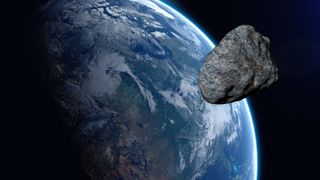You can watch a huge, mile-wide asteroid fly safely by Earth today
The asteroid just over 1 mile wide, but poses no immediate threat to us.
Update for 12 pm ET: The live webcast of asteroid 7335 (1989 JA) has concluded. Read our wrap of the asteroid flyby and see a replay of the webcast above.
A huge asteroid more than a mile wide will zoom safely by Earth today and you can watch it live today in a free online webcast.
The asteroid, known as asteroid 7335 (1989 JA), is four times the size of the Empire State Building and will pass the Earth at a distance about 10 times that of the space between the Earth and moon. It is the largest asteroid flyby of 2022 yet, but the space rock will remain at a perfectly safe distance to our planet.
The Virtual Telescope Project will run a webcast of the flyby at 9 a.m. EDT (1300 GMT) on May 27; you can watch the flyby in the window above or directly through the project's website.
Related: The greatest asteroid missions of all time!

Looking for a telescope for the next skywatching event? We recommend the Celestron Astro Fi 102 as the top pick in our best beginner's telescope guide.
Asteroid 7335 (1989 JA) is roughly 1.1. miles (1.8 kilometers) in diameter and its closest approach is a quite healthy 2.5 million miles (4 million km) away from Earth. The asteroid should be bright enough to glimpse in a moderate-sized amateur telescope, particularly from the southern hemisphere, Virtual Telescope Project founder Gianluca Masi noted.
Asteroid 7335 (1989 JA) is technically classified as "potentially hazardous," but that is more a designation based on its relative size (larger than 492 feet or 150 m) and the distance at which the object approaches Earth, among other factors.
Get the Space.com Newsletter
Breaking space news, the latest updates on rocket launches, skywatching events and more!
NASA's Planetary Defense Coordination Office has found the object to be no threat at all. You can keep track of other prominent upcoming flybys and the agency's Small-Body Database to learn more about asteroids.
The agency does maintain a curated list of asteroids with a tiny and statistically improbable chance of impact, but none of these are an immediate worry. The agency also keeps this pate updated. For example, asteroid Apophis was removed from the list in 2021 after new observations show it poses no threat at all in the next century.

Agencies around the world are also conducting missions to learn more about the composition and history of asteroids.
Examples include the Double Asteroid Redirection Test (DART) mission aiming to redirect a moonlet (asteroid moon) and OSIRIS-REX (Origins, Spectral Interpretation, Resource Identification, Security, Regolith Explorer), which will bring a sample of asteroid Bennu to Earth in 2023.
These missions are done to assess the composition of asteroids just in case, and space agencies are also getting better at tracking asteroids. That's why it might appear there are so many space rocks going by us these days.
Follow Elizabeth Howell on Twitter @howellspace. Follow us on Twitter @Spacedotcom and on Facebook.
Join our Space Forums to keep talking space on the latest missions, night sky and more! And if you have a news tip, correction or comment, let us know at: community@space.com.

Elizabeth Howell (she/her), Ph.D., is a staff writer in the spaceflight channel since 2022 covering diversity, education and gaming as well. She was contributing writer for Space.com for 10 years before joining full-time. Elizabeth's reporting includes multiple exclusives with the White House and Office of the Vice-President of the United States, an exclusive conversation with aspiring space tourist (and NSYNC bassist) Lance Bass, speaking several times with the International Space Station, witnessing five human spaceflight launches on two continents, flying parabolic, working inside a spacesuit, and participating in a simulated Mars mission. Her latest book, "Why Am I Taller?", is co-written with astronaut Dave Williams. Elizabeth holds a Ph.D. and M.Sc. in Space Studies from the University of North Dakota, a Bachelor of Journalism from Canada's Carleton University and a Bachelor of History from Canada's Athabasca University. Elizabeth is also a post-secondary instructor in communications and science at several institutions since 2015; her experience includes developing and teaching an astronomy course at Canada's Algonquin College (with Indigenous content as well) to more than 1,000 students since 2020. Elizabeth first got interested in space after watching the movie Apollo 13 in 1996, and still wants to be an astronaut someday. Mastodon: https://qoto.org/@howellspace
